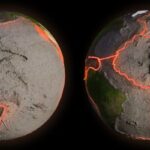We explain what a tsunami is and how this oceanic phenomenon occurs. Also, the Japan tsunami and what an earthquake is.

What is a tsunami?
Tsunami is a term from Japanese (tsu“port or bay” + nami“wave”), synonymous with tidal wave (from Latin: sea“sea” + motus“movement”), and with both a complex oceanic phenomenon is described, characterized by waves of large size and energy which mobilize gigantic quantities of water, reaching deep into dry land and destroying everything in its path.
Tsunamis should not be confused with other maritime movements such as waves, tides or floods resulting from storms, storms, hurricanes or tropical storms. Tsunamis are not generated by the action of the wind, as in those cases, but as consequence of an underwater seismic movement an underwater earthquake.
Tsunamis have enormous destructive capacity and are generally, along with fires and landslides, some of the biggest concerns after an earthquake of considerable magnitude. That's why Tsunami warning is usually issued immediately after a tremor or earthquake ends whose epicenter is in the ocean or in a coastal location.
The area of the world with the highest frequency of tsunamis on the planet is in the Pacific Ocean: the so-called “ring of fire” of great seismic and volcanic activity, which covers part of the territories of Argentina, Bolivia, Brunei, Canada, Chile, Colombia, Costa Rica, Ecuador, El Salvador, United States, Philippines, Guatemala, Honduras, Indonesia, Japan, Malaysia, Mexico, Nicaragua, Panama, Papua New Guinea, Peru, Russia, Samoa, Singapore, Taiwan, East Timor and Tonga, as well as the Aleutian Islands, Solomon Islands.
How does a tsunami occur?
As we have said, a tsunami is a direct consequence of an underwater tremor, whose telluric waves are transmitted to the water and are magnified enough to generate a gigantic wave. A minimal unevenness of the seabed is enough for this, since the enormous mass of ocean water moves and, upon regaining its balance, generates a sea wave with enough energy to travel kilometers in a very short time.
These waves are practically invisible on the high seas, until they reach shallower waters. There they must lose speed thanks to friction with the sea floor, however compensating for it with height: the result is a sequence of colossal waves breaking on the coast and that flood solid land.
Japan Tsunami

In 2011, Japan was the scene of one of the most violent tsunamis known in contemporary times. This phenomenon was part of the so-called Pacific Coast Earthquake in the Töhoku Region of 2011 (according to the Japanese meteorological agency), which was particularly disastrous for the Asian nation.
This earthquake It had an intensity of 9.0 Mw and created tsunami waves up to 40.5 meters high. Its epicenter was located in the sea, off the coast of Honshu, Japan, at a depth of 32 kilometers, and occurred at 2:46 pm (local time), lasting approximately 6 minutes. Immediately after the earthquake there were two or three aftershocks of more than 7 intensity points, and then about 1,230 smaller aftershocks.
In the incident about 15,893 people died about 6,152 were injured and about 2,556 disappeared in total. It is the largest earthquake suffered by Japan so far and the fourth largest recorded in the entire world.
Tsunami and earthquake
Tsunamis are, as we have seen, consequences of an earthquake. However, Not all earthquakes necessarily produce tsunamis..
An earthquake is, fundamentally, a sudden movement of the tectonic plates of the Earth's surface, which when rearranging their position tend to collide, push or stress, generating vibrations that are transmitted along its surface, maximizing as they move outward.
They may be some of the most catastrophic and unpredictable natural phenomena known to humanity.





